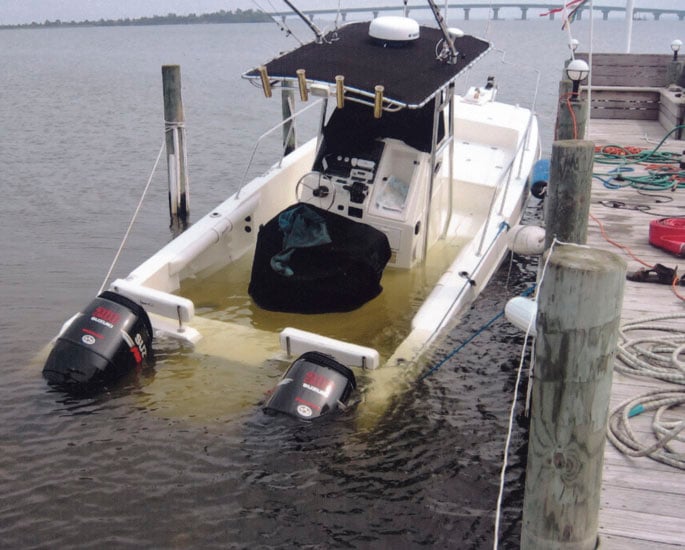How to Benefit From The Competition for Your Money

In the latest sign that the competition for your money is as hot as Texas in August, Fidelity Investments says that customers who open individual brokerage and retirement accounts will now automatically have their uninvested cash directed into a higher yielding money market fund. The move will especially benefit those who leave substantial amounts uninvested for a long time.
That goes against the typical industry practice of sweeping the money, by default, into a low-yielding account at what’s typically an affiliated bank.
“Some firms have removed the option of securing a higher yielding money market fund as an option for their cash, thereby forcing investors to take additional steps to get a better rate,” says Kathleen Murphy, president of Fidelity Investments’ personal investing business. “Unfortunately, that means millions of people don’t get the opportunity to have that money earn more for them.”
So exactly how much, in
actual dollars, do you stand to benefit from the new policy?
If, for example, you’re opening an account with $10,000. If you’re like many investors, research shows that not only will you not focus on the rate paid on that cash deposit – typically called the bank cash sweep – but there’s a good chance of the following scenario playing out:
• You keep waiting for the so-called “perfect time” to actually invest the money.
• Meanwhile, while you’re waiting, life gets in the way and you’re too busy to even park the cash in a higher-yielding alternative to the sweep.
And so the cash just sits there.
And sits there.
The annual yield on that $10,000, when defaulted into a cash sweep, is a mere 0.03 percent at E-Trade, 0.04 percent at TD Ameritrade, and 0.18 percent at Charles Schwab, to cite three prominent examples as of August 11.
That works out, respectively, to $3, $4 and $18.
By comparison, with Fidelity now automatically directing the cash into its
Fidelity Government Money Market Fund (SPAXX), you could earn $183 annually thanks to its much higher 1.83 percent seven-day yield, as of August 11.
The difference is even starker the more cash you’re sitting on.
Have $50,000? That works out to $915 annually vs. a cash sweep of as little as $15.
Double that to $100,000, and we’re talking $1,830 annually compared to a cash sweep of as little as $30.
There’s nothing exotic about money market funds. Though they’re not FDIC-insured as bank sweeps are, they’ve been around since the 1970s and are simply mutual funds that invest in short-term debt securities carrying low credit risk. Their underlying securities are issued by government entities or companies that borrow money and repay the principal and interest to investors within a short period of time.
The move is just the latest
value enhancement by Fidelity, the nation’s largest retirement and brokerage firm with nearly $8 trillion in client assets. Last year it introduced four new U.S. and global index funds with zero expense fees, eliminated minimum amounts required to invest in any Fidelity mutual fund and 529 College Savings Plan, and did away with individual investors’ charges for things such as domestic bank wires and check-stop payments.
“We’re once again rewriting the rules of investing,” says Murphy.
 – The arrival of the new year means new decisions for students planning their futures and seeking a career path that not only suits their strengths, but also brings them satisfaction and security.The transportation industry in the United States continues to experience a workforce shortage, and may be the ideal path for hands-on learners whose talents and interests may be well suited for a successful and satisfying technician career.The nonprofit TechForce Foundation has launched the "Be a Pathfinder" campaign to help students with natural talents for hands-on professions discover their strengths and learning styles, and explore a career they might not have considered: that of a transportation technician.The "Be a Pathfinder" campaign features a free learning-styles quiz on the TechForce website that generates a report for students and parents with personalized career tips based on their unique learning styles. Students who take the quiz are entered to win a TechForce Foundation gift package that includes a $50 Shell gift card and other prizes."The learning style quiz and personalized resources not only help students and parents recognize the opportunities of a career as a transportation technician, but also help them understand how and why they’re a fit for these careers," says TechForce Foundation Executive Director Jennifer Maher.The campaign encourages students to be "pathfinders" by helping them discover and understand their unique strengths and use that knowledge to choose an educational and career path. TechForce Foundation’s mission is to promote the potential of professional technician careers, and to encourage parents, teachers, and other influential figures in teens’ lives to recognize and support technical careers that may be a good fit for those students.Studies suggest that the U.S. will need 1.2 million new technicians within the next decade, which translates to about 120,000 new jobs per year for aspiring professionals with interest in and aptitude for automotive, diesel, motorcycle, and other transportation fields."Though there are many viable, high-paying job opportunities in STEM-related careers like those in the transportation technician field, students have been told a traditional four-year degree is the only path to success," Maher emphasizes."The truth is that we’re all wired differently, and hands-on learners can thrive in these positions."Students and parents can take the learning-styles quiz at TechForce.org/MyPath.Additional stories, videos, and resources are available on TechForce Foundation’s website, Facebook, Twitter, LinkedIn, and Instagram accounts.Visit techforce.org for more information about TechForce’s work and pathways to rewarding careers.
– The arrival of the new year means new decisions for students planning their futures and seeking a career path that not only suits their strengths, but also brings them satisfaction and security.The transportation industry in the United States continues to experience a workforce shortage, and may be the ideal path for hands-on learners whose talents and interests may be well suited for a successful and satisfying technician career.The nonprofit TechForce Foundation has launched the "Be a Pathfinder" campaign to help students with natural talents for hands-on professions discover their strengths and learning styles, and explore a career they might not have considered: that of a transportation technician.The "Be a Pathfinder" campaign features a free learning-styles quiz on the TechForce website that generates a report for students and parents with personalized career tips based on their unique learning styles. Students who take the quiz are entered to win a TechForce Foundation gift package that includes a $50 Shell gift card and other prizes."The learning style quiz and personalized resources not only help students and parents recognize the opportunities of a career as a transportation technician, but also help them understand how and why they’re a fit for these careers," says TechForce Foundation Executive Director Jennifer Maher.The campaign encourages students to be "pathfinders" by helping them discover and understand their unique strengths and use that knowledge to choose an educational and career path. TechForce Foundation’s mission is to promote the potential of professional technician careers, and to encourage parents, teachers, and other influential figures in teens’ lives to recognize and support technical careers that may be a good fit for those students.Studies suggest that the U.S. will need 1.2 million new technicians within the next decade, which translates to about 120,000 new jobs per year for aspiring professionals with interest in and aptitude for automotive, diesel, motorcycle, and other transportation fields."Though there are many viable, high-paying job opportunities in STEM-related careers like those in the transportation technician field, students have been told a traditional four-year degree is the only path to success," Maher emphasizes."The truth is that we’re all wired differently, and hands-on learners can thrive in these positions."Students and parents can take the learning-styles quiz at TechForce.org/MyPath.Additional stories, videos, and resources are available on TechForce Foundation’s website, Facebook, Twitter, LinkedIn, and Instagram accounts.Visit techforce.org for more information about TechForce’s work and pathways to rewarding careers.



 (
( – All artists have one thing in common — they start with a blank canvas.In the case of George Sosnak, a folk artist whose work is being exhibited through August at the Chrysler Museum of Art in Norfolk, Va., his canvas of choice happened to be a part of America’s favorite pastime — baseball.To understand the artist, you have to understand the medium, its history, and the man behind the art.It was around this small, leather ball that the artist found a way to express his love of the game.While Sosnak was passionate about baseball, he was athletically unskilled as a player. So, he did the next best thing — he became an umpire. After World War II, he landed in the Pioneer League for the 1956-1958 seasons, later going on to umpire in the Three-I League (Iowa, Idaho, and Indiana) and Southern Association, before both leagues folded. With that, his dream of becoming a Major League umpire died. The Artist Within Emerges His calling to art came in the form of an odd request from a female fan while he was umpiring a game in Idaho in 1956: Could he paint her favorite player on a baseball?From there, the seed of an idea began and became an outlet for Sosnak to maintain his passion and connection to baseball in a way that he had never envisioned.Demand soon followed — from politicians to U.S. presidents to baseball players and fans to foreign dignitaries, sportswriters, churches, and charities. On occasion, Sosnak would be paid for his work; oftentimes, he would give the baseball to the player, person, or organization as a gift.Over time, as with any artist, Sosnak’s technique developed to the point that baseballs became murals for his work. Using India ink, Sosnak would meticulously and elaborately cover the ball with microscopic text and colorful backgrounds. Many times, he would include logos from a certain team, using arcane material that he researched, commemorating everything from a player’s stats to the night of Aug. 6, 1967 when Dean Chance of the Minnesota Twins pitched a perfect no-hitter against the Red Sox for five innings before the game was called because of rain. Collectors Abound Before his death in 1992, auction houses believe Sosnak created somewhere between 800 and 3,000 baseballs. As for worth, prices started creeping up posthumously as more people realized the individuality of his work. In 2009, the market was anywhere from $500 to several thousand dollars for a ball.For fans who may not be able to afford a Sosnak baseball but would love to see his work, the Chrysler Museum of Art in Norfolk, VA., is exhibiting his baseballs until Aug. 27. Admission is free."His work combines the whimsical, artistic expression with endless statistics and game descriptions, that are so beloved by baseball fans," says Susan Leidy, deputy director of the museum."Even if you’re not a folk art fan, it’s fun to see every possible detail about someone’s career [because] everything is on these balls in the tiniest possible writing."For more information, visit
– All artists have one thing in common — they start with a blank canvas.In the case of George Sosnak, a folk artist whose work is being exhibited through August at the Chrysler Museum of Art in Norfolk, Va., his canvas of choice happened to be a part of America’s favorite pastime — baseball.To understand the artist, you have to understand the medium, its history, and the man behind the art.It was around this small, leather ball that the artist found a way to express his love of the game.While Sosnak was passionate about baseball, he was athletically unskilled as a player. So, he did the next best thing — he became an umpire. After World War II, he landed in the Pioneer League for the 1956-1958 seasons, later going on to umpire in the Three-I League (Iowa, Idaho, and Indiana) and Southern Association, before both leagues folded. With that, his dream of becoming a Major League umpire died. The Artist Within Emerges His calling to art came in the form of an odd request from a female fan while he was umpiring a game in Idaho in 1956: Could he paint her favorite player on a baseball?From there, the seed of an idea began and became an outlet for Sosnak to maintain his passion and connection to baseball in a way that he had never envisioned.Demand soon followed — from politicians to U.S. presidents to baseball players and fans to foreign dignitaries, sportswriters, churches, and charities. On occasion, Sosnak would be paid for his work; oftentimes, he would give the baseball to the player, person, or organization as a gift.Over time, as with any artist, Sosnak’s technique developed to the point that baseballs became murals for his work. Using India ink, Sosnak would meticulously and elaborately cover the ball with microscopic text and colorful backgrounds. Many times, he would include logos from a certain team, using arcane material that he researched, commemorating everything from a player’s stats to the night of Aug. 6, 1967 when Dean Chance of the Minnesota Twins pitched a perfect no-hitter against the Red Sox for five innings before the game was called because of rain. Collectors Abound Before his death in 1992, auction houses believe Sosnak created somewhere between 800 and 3,000 baseballs. As for worth, prices started creeping up posthumously as more people realized the individuality of his work. In 2009, the market was anywhere from $500 to several thousand dollars for a ball.For fans who may not be able to afford a Sosnak baseball but would love to see his work, the Chrysler Museum of Art in Norfolk, VA., is exhibiting his baseballs until Aug. 27. Admission is free."His work combines the whimsical, artistic expression with endless statistics and game descriptions, that are so beloved by baseball fans," says Susan Leidy, deputy director of the museum."Even if you’re not a folk art fan, it’s fun to see every possible detail about someone’s career [because] everything is on these balls in the tiniest possible writing."For more information, visit  (
( – Working batteries in smoke alarms? Check. Fresh oil in your car? Check. New water filter for your fridge? Check. But how many people think about regularly checking their tires? As fall travel and winter weather loom on the horizon, taking a moment to check your car tires can make a difference in keeping you safe on the road.This year, Cooper Tires is encouraging drivers to mark Labor Day weekend (and the first of every month) as a tire check safety moment, to make a habit of checking tires, especially as seasons change."Just as we regularly take a moment to check our smoke detector batteries when we change our clocks in the fall and spring, we need to designate a moment to check tire safety as well," says Jessica Egerton, Director of Brand Development at Cooper Tire & Rubber Company.Checking the overall condition of your tires is easy and important for your safety on the road. Your tires are the only parts of your vehicle to come into contact with, and keep you connected to, the road.The recommended tread depth is more than 2/32 of an inch deep. Do your tires meet this minimum, or are they too worn? Would you know if they are? An easy and quick way to tell is to stick a penny into the tread with Lincoln’s head facing down. If the tread covers the top of his head, you’re good to go. If not, time to replace the tire.Ensuring your tires have the recommended tread depth can help in a variety of ways, including maintaining traction on the road, keeping control of the car, and preventing hydroplaning or sliding.Don’t be under-pressured, either.Tires not inflated to the recommended level of pressure can lead to tire failure, uneven wear and cause your car to use more gas.Try this 10-minute safety check from Cooper Tires:* Check the tread. Use the U.S. penny/Lincoln’s head method. Insert the penny into the tire tread, with Lincoln’s head down and facing you. If the top of his head is visible at any point around the tire, there is too little tread, and it’s time to replace the tire!* Check the pressure. Look on the vehicle doorjamb, glove compartment, fuel door or owner’s manual to find the recommended pressure for your tires. Press a tire gauge on the valve stem. Too low? Add air. Too high? Push down on the metal stem in the center of the valve to release some air. When you reach the recommended pressure, replace that valve cap. Also, don’t check pressure right after driving. Wait at least three hours until the tires are cool.* Check your look. Inspect your tires for cuts, bulges, cracks, splits or punctures. When in doubt, ask a tire professional for an inspection.Visit
– Working batteries in smoke alarms? Check. Fresh oil in your car? Check. New water filter for your fridge? Check. But how many people think about regularly checking their tires? As fall travel and winter weather loom on the horizon, taking a moment to check your car tires can make a difference in keeping you safe on the road.This year, Cooper Tires is encouraging drivers to mark Labor Day weekend (and the first of every month) as a tire check safety moment, to make a habit of checking tires, especially as seasons change."Just as we regularly take a moment to check our smoke detector batteries when we change our clocks in the fall and spring, we need to designate a moment to check tire safety as well," says Jessica Egerton, Director of Brand Development at Cooper Tire & Rubber Company.Checking the overall condition of your tires is easy and important for your safety on the road. Your tires are the only parts of your vehicle to come into contact with, and keep you connected to, the road.The recommended tread depth is more than 2/32 of an inch deep. Do your tires meet this minimum, or are they too worn? Would you know if they are? An easy and quick way to tell is to stick a penny into the tread with Lincoln’s head facing down. If the tread covers the top of his head, you’re good to go. If not, time to replace the tire.Ensuring your tires have the recommended tread depth can help in a variety of ways, including maintaining traction on the road, keeping control of the car, and preventing hydroplaning or sliding.Don’t be under-pressured, either.Tires not inflated to the recommended level of pressure can lead to tire failure, uneven wear and cause your car to use more gas.Try this 10-minute safety check from Cooper Tires:* Check the tread. Use the U.S. penny/Lincoln’s head method. Insert the penny into the tire tread, with Lincoln’s head down and facing you. If the top of his head is visible at any point around the tire, there is too little tread, and it’s time to replace the tire!* Check the pressure. Look on the vehicle doorjamb, glove compartment, fuel door or owner’s manual to find the recommended pressure for your tires. Press a tire gauge on the valve stem. Too low? Add air. Too high? Push down on the metal stem in the center of the valve to release some air. When you reach the recommended pressure, replace that valve cap. Also, don’t check pressure right after driving. Wait at least three hours until the tires are cool.* Check your look. Inspect your tires for cuts, bulges, cracks, splits or punctures. When in doubt, ask a tire professional for an inspection.Visit  – Six is a memorable number – It’s the number of players on a volleyball team, geese a-laying in “The 12 Days of Christmas,” and characters in Friends. There are also six main types of K-12 learning environments families can choose from. As we gear up for National School Choice Week (Jan. 26 – Feb. 1), can you name all six types of schools?
– Six is a memorable number – It’s the number of players on a volleyball team, geese a-laying in “The 12 Days of Christmas,” and characters in Friends. There are also six main types of K-12 learning environments families can choose from. As we gear up for National School Choice Week (Jan. 26 – Feb. 1), can you name all six types of schools?
 (
( – Today’s technology has changed the shopping experience. While many of us still enjoy trying on clothes at our favorite department store, we also relish the ability to buy specific and unique items through an e-commerce app, or research product details via our smartphone.The changing nature of retail has opened tremendous opportunities for small businesses in the past decade. According to new research, "
– Today’s technology has changed the shopping experience. While many of us still enjoy trying on clothes at our favorite department store, we also relish the ability to buy specific and unique items through an e-commerce app, or research product details via our smartphone.The changing nature of retail has opened tremendous opportunities for small businesses in the past decade. According to new research, " (
( – The Medicare Annual Election Period takes place this fall from Oct. 15 through Dec. 7. It’s a time for people with Medicare to make important decisions about their health care.There are many factors, in addition to premiums and medical provider networks, to consider when researching the Medicare plan that best meets your health and budget needs for 2018. Knowing the benefits offered by Medicare Advantage plans and Medicare Prescription Drug Plans — both offer enhancements to Original Medicare — will also be key in your decision making.Here are five common hiccups Medicare beneficiaries may experience when considering their options:* Your monthly payments are not the only thing to consider. After you analyze your previous year’s plan and assess the most affordable option for the coming year, including extra costs that can be incurred down the road, consider the total value of the Medicare plan you select.* Your drug coverage is not the same everywhere. Drug prices can vary depending on your location, pharmacy and how much you’ve used your prescription benefits. Make a list of your medications and consider prescription drug plan options that include mail-order.* Your plan is not just for medical visits or emergencies. People living with a chronic condition may want to look for plans offering personalized care, such as health coaching. Many Medicare Advantage programs also offer benefits, such as fitness programs, for maintaining healthy, active lifestyles.* You may not need the same plan as your spouse/significant other. It’s important for spouses to sit down and assess your health needs, and doctors and hospitals. This ensures your Medicare plan makes sense for your health, budget and lifestyle.* You’re not on your own in making this decision. Utilize free resources, such as licensed Medicare health insurance agents,
– The Medicare Annual Election Period takes place this fall from Oct. 15 through Dec. 7. It’s a time for people with Medicare to make important decisions about their health care.There are many factors, in addition to premiums and medical provider networks, to consider when researching the Medicare plan that best meets your health and budget needs for 2018. Knowing the benefits offered by Medicare Advantage plans and Medicare Prescription Drug Plans — both offer enhancements to Original Medicare — will also be key in your decision making.Here are five common hiccups Medicare beneficiaries may experience when considering their options:* Your monthly payments are not the only thing to consider. After you analyze your previous year’s plan and assess the most affordable option for the coming year, including extra costs that can be incurred down the road, consider the total value of the Medicare plan you select.* Your drug coverage is not the same everywhere. Drug prices can vary depending on your location, pharmacy and how much you’ve used your prescription benefits. Make a list of your medications and consider prescription drug plan options that include mail-order.* Your plan is not just for medical visits or emergencies. People living with a chronic condition may want to look for plans offering personalized care, such as health coaching. Many Medicare Advantage programs also offer benefits, such as fitness programs, for maintaining healthy, active lifestyles.* You may not need the same plan as your spouse/significant other. It’s important for spouses to sit down and assess your health needs, and doctors and hospitals. This ensures your Medicare plan makes sense for your health, budget and lifestyle.* You’re not on your own in making this decision. Utilize free resources, such as licensed Medicare health insurance agents,  (
( (
( (
( – Sponsored News – Working mothers have a lot on their plate. In addition to their professional responsibilities, they are often in charge of numerous household decisions, including choosing their family’s health care plan. However, nearly half (49 percent) of working mothers would not have enough money to cover their health insurance deductible if they needed to do so today, according to a recent survey from Aflac and
– Sponsored News – Working mothers have a lot on their plate. In addition to their professional responsibilities, they are often in charge of numerous household decisions, including choosing their family’s health care plan. However, nearly half (49 percent) of working mothers would not have enough money to cover their health insurance deductible if they needed to do so today, according to a recent survey from Aflac and  (
( – So much for fancy cars, houses and jewelry.Eighty-one percent of Americans believe their "most valuable asset" is their family, according to a new survey by Edward Jones and the nonprofit consumer-education organization Life Happens. And one quarter of respondents in the national sampling of adults confessed that their biggest fear was saddling their nearest and dearest with unexpected financial burdens if they’re unable to work or die prematurely.Which begs the question: If we’re so worried about protecting what we treasure most, why don’t more people have life insurance?Ask most experts, and they’ll tell you that such policies can help provide crucial resources for anyone with loved ones to support. And yet the latest figures show only 41 percent of U.S. households have individual life insurance."Most Americans have little or no safeguards for their financial goals," says Ken Cella, principal of the Client Strategies Group at the financial services firm Edward Jones. "They may understand the value of having emergency funds to cover unexpected financial expenses in the short
– So much for fancy cars, houses and jewelry.Eighty-one percent of Americans believe their "most valuable asset" is their family, according to a new survey by Edward Jones and the nonprofit consumer-education organization Life Happens. And one quarter of respondents in the national sampling of adults confessed that their biggest fear was saddling their nearest and dearest with unexpected financial burdens if they’re unable to work or die prematurely.Which begs the question: If we’re so worried about protecting what we treasure most, why don’t more people have life insurance?Ask most experts, and they’ll tell you that such policies can help provide crucial resources for anyone with loved ones to support. And yet the latest figures show only 41 percent of U.S. households have individual life insurance."Most Americans have little or no safeguards for their financial goals," says Ken Cella, principal of the Client Strategies Group at the financial services firm Edward Jones. "They may understand the value of having emergency funds to cover unexpected financial expenses in the short  (
( (
( (
( (
( – Fall means not only shorter days and colorful leaves, but also the season of open enrollment for health insurance for most Americans.Employer-sponsored benefits can be confusing, and a combination of doing some homework and seeking expert advice can help most individuals make the most of the plans available to them.Confusion over health insurance remains a common problem; approximately 76 percent of American workers reported that they did not understand some elements of their health insurance, according to the 2017 Aflac WorkForces Report conducted by Lightspeed GMI on behalf of insurance provider Aflac.Areas of concern reported by survey respondents included deductibles, copays, and the determination of whether a health care provider is in-network.Consumer education is the key to making smart decisions during open enrollment periods, according to Aflac, which offers three top tips for maximizing health insurance.-Be prepared. Before your employer opens enrollment for health insurance this year, take the time to look into all the available options. Data from Aflac’s consumer survey showed that 83 percent of workers spent less than an hour researching potential health insurance benefit plans, and 20 percent of those did no research on health insurance plans at all.-Be advised. Get expert help. The Aflac survey found that approximately two-thirds (67 percent) of workers said they were confident that they understood all aspects of the health insurance plans for which they signed up.However, only 24 percent said they understood everything when they were questioned in more detail about deductibles, copays, and in-network providers.-Be enhanced. Consider additional voluntary insurance coverage to help fill the holes in employer-offered plans. Approximately 81 percent of employees report a need for voluntary insurance benefits, according to the Aflac survey, and 90 percent say that they view voluntary insurance as essential to a complete health benefits program.Some examples of voluntary insurance include not only health insurance, but also accident insurance, insurance for critical illness, and insurance for hospital stays, which may not be covered by an employer’s insurance. Voluntary insurance also can be used to help with expenses associated with gas, groceries, and rent for individuals with illnesses or injuries that prevent them from working.Visit
– Fall means not only shorter days and colorful leaves, but also the season of open enrollment for health insurance for most Americans.Employer-sponsored benefits can be confusing, and a combination of doing some homework and seeking expert advice can help most individuals make the most of the plans available to them.Confusion over health insurance remains a common problem; approximately 76 percent of American workers reported that they did not understand some elements of their health insurance, according to the 2017 Aflac WorkForces Report conducted by Lightspeed GMI on behalf of insurance provider Aflac.Areas of concern reported by survey respondents included deductibles, copays, and the determination of whether a health care provider is in-network.Consumer education is the key to making smart decisions during open enrollment periods, according to Aflac, which offers three top tips for maximizing health insurance.-Be prepared. Before your employer opens enrollment for health insurance this year, take the time to look into all the available options. Data from Aflac’s consumer survey showed that 83 percent of workers spent less than an hour researching potential health insurance benefit plans, and 20 percent of those did no research on health insurance plans at all.-Be advised. Get expert help. The Aflac survey found that approximately two-thirds (67 percent) of workers said they were confident that they understood all aspects of the health insurance plans for which they signed up.However, only 24 percent said they understood everything when they were questioned in more detail about deductibles, copays, and in-network providers.-Be enhanced. Consider additional voluntary insurance coverage to help fill the holes in employer-offered plans. Approximately 81 percent of employees report a need for voluntary insurance benefits, according to the Aflac survey, and 90 percent say that they view voluntary insurance as essential to a complete health benefits program.Some examples of voluntary insurance include not only health insurance, but also accident insurance, insurance for critical illness, and insurance for hospital stays, which may not be covered by an employer’s insurance. Voluntary insurance also can be used to help with expenses associated with gas, groceries, and rent for individuals with illnesses or injuries that prevent them from working.Visit  (
( – Having the proper insurance may not be the most exciting part of owning a boat, but being savvy matters; the right coverage saves money, time, and hassle in case of an emergency.As a new boating season gets underway, boat owners should know the basics of different types of insurance coverage, review their current plan, and be sure they have the one that best meets their needs.Some key areas of coverage to consider this season include:- Salvage savvy. No one wants to lose a boat, but if the worst happens, don’t assume salvage is part of your insurance policy.According to the Boat Owners Association of The United States (BoatUS), some boat insurers will subtract the cost of salvage from the boat’s insured value. That means owners receive reduced funds for repairs, or less money back if the boat is a total loss. So seek out a policy that offers salvage coverage separate, but equal to the hull-value coverage.- Consequential concerns. Consequential damage is a tricky area of boat insurance. Data from BoatUS indicate that about half of all sinkings occur when the boat is docked and a small part below the waterline fails, often as a result of wear and tear, corrosion, or inadequate maintenance.An insurance policy may not cover the failed part, but ensure that it covers "consequential damage," such as major repairs or the cost of the boat in cases of total loss in the wake of a failed part.This consequential damage coverage generally only applies to major or total losses. It’s typical, for example, to cover the immediate consequential damage resulting from any sinking, fire, explosion, demasting, collision or stranding.- Rescue review. On-water towing assistance is an element of some boat insurance policies, but understand what type is right for your needs.If you have only one boat, ask your insurance company whether it offers a towing service. Some companies, such as BoatUS, have their own towing fleet. Important questions for your insurance company: Who is providing the towing service, if not their own fleet? Is there 24-hour service? Will you have to pay out of pocket and seek reimbursement?For more tips and information to optimize your boat insurance, visit
– Having the proper insurance may not be the most exciting part of owning a boat, but being savvy matters; the right coverage saves money, time, and hassle in case of an emergency.As a new boating season gets underway, boat owners should know the basics of different types of insurance coverage, review their current plan, and be sure they have the one that best meets their needs.Some key areas of coverage to consider this season include:- Salvage savvy. No one wants to lose a boat, but if the worst happens, don’t assume salvage is part of your insurance policy.According to the Boat Owners Association of The United States (BoatUS), some boat insurers will subtract the cost of salvage from the boat’s insured value. That means owners receive reduced funds for repairs, or less money back if the boat is a total loss. So seek out a policy that offers salvage coverage separate, but equal to the hull-value coverage.- Consequential concerns. Consequential damage is a tricky area of boat insurance. Data from BoatUS indicate that about half of all sinkings occur when the boat is docked and a small part below the waterline fails, often as a result of wear and tear, corrosion, or inadequate maintenance.An insurance policy may not cover the failed part, but ensure that it covers "consequential damage," such as major repairs or the cost of the boat in cases of total loss in the wake of a failed part.This consequential damage coverage generally only applies to major or total losses. It’s typical, for example, to cover the immediate consequential damage resulting from any sinking, fire, explosion, demasting, collision or stranding.- Rescue review. On-water towing assistance is an element of some boat insurance policies, but understand what type is right for your needs.If you have only one boat, ask your insurance company whether it offers a towing service. Some companies, such as BoatUS, have their own towing fleet. Important questions for your insurance company: Who is providing the towing service, if not their own fleet? Is there 24-hour service? Will you have to pay out of pocket and seek reimbursement?For more tips and information to optimize your boat insurance, visit  (
( – Not long ago we only used cell phones to make calls or send cryptic, short-hand text messages. Now, we rely on our phones for storing our contacts and calendar appointments, watching videos, checking email, managing our connected devices and, of course, keeping up on social media. In fact, phones have become such a crucial part of our lives that many people sleep with them.
– Not long ago we only used cell phones to make calls or send cryptic, short-hand text messages. Now, we rely on our phones for storing our contacts and calendar appointments, watching videos, checking email, managing our connected devices and, of course, keeping up on social media. In fact, phones have become such a crucial part of our lives that many people sleep with them.